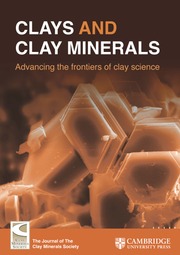Crossref Citations
This article has been cited by the following publications. This list is generated based on data provided by
Crossref.
McConville, Caspar J.
and
Lee, William Edward
2005.
Microstructural Development on Firing Illite and Smectite Clays Compared with that in Kaolinite.
Journal of the American Ceramic Society,
Vol. 88,
Issue. 8,
p.
2267.
Rasmussen, Birger
2005.
Zircon growth in very low grade metasedimentary rocks: evidence for zirconium mobility at ~250°C.
Contributions to Mineralogy and Petrology,
Vol. 150,
Issue. 2,
p.
146.
Kolaříková, I.
Přikryl, R.
Hanus, R.
and
Jelínek, E.
2005.
Thermal loading of smectite-rich rocks: Natural processes vs. laboratory experiments.
Applied Clay Science,
Vol. 29,
Issue. 3-4,
p.
215.
González, I.
Galán, E.
and
Miras, A.
2006.
Fluorine, chlorine and sulphur emissions from the Andalusian ceramic industry (Spain)—Proposal for their reduction and estimation of threshold emission values.
Applied Clay Science,
Vol. 32,
Issue. 3-4,
p.
153.
Marina Vargas Rodríguez, Y.
Beltrán, Hiram I.
Vázquez-Labastida, Eloy
Linares-López, Carlos
and
Salmón, Manuel
2007.
Synthesis and characterization of montmorillonite clays with modulable porosity induced with acids and superacids.
Journal of Materials Research,
Vol. 22,
Issue. 3,
p.
788.
Fischer, Håkon
Weidler, Peter G.
Grobéty, Bernard
Luster, Jörg
and
Gehring, Andreas U.
2009.
The transformation of synthetic hectorite in the presence of Cu(II).
Clays and Clay Minerals,
Vol. 57,
Issue. 2,
p.
139.
Cheng, Hongfei
Yang, Jing
Liu, Qinfu
He, Junkai
and
Frost, Ray L.
2010.
Thermogravimetric analysis–mass spectrometry (TG–MS) of selected Chinese kaolinites.
Thermochimica Acta,
Vol. 507-508,
Issue. ,
p.
106.
Cheng, Hongfei
Liu, Qinfu
Yang, Jing
and
Frost, Ray L.
2010.
Thermogravimetric analysis of selected coal-bearing strata kaolinite.
Thermochimica Acta,
Vol. 507-508,
Issue. ,
p.
84.
García-Ten, J.
Monfort, E.
Gómez-Tena, M.P.
and
Sanz, V.
2011.
Use of coatings to minimise acid emissions during ceramic tile firing.
Journal of Cleaner Production,
Vol. 19,
Issue. 9-10,
p.
1110.
Monfort, E.
Celades, I.
Gomar, S.
Rueda, F.
and
Martínez, J.
2011.
Caracterización de las emisiones de contaminantes ácidos en la fabricación de baldosas cerámicas.
Boletín de la Sociedad Española de Cerámica y Vidrio,
Vol. 50,
Issue. 4,
p.
179.
Cheng, Hongfei
Liu, Qinfu
Huang, Man
Zhang, Shilong
and
Frost, Ray L.
2013.
Application of TG-FTIR to study SO2 evolved during the thermal decomposition of coal-derived pyrite.
Thermochimica Acta,
Vol. 555,
Issue. ,
p.
1.
Emmerich, K.
2013.
Handbook of Clay Science.
Vol. 5,
Issue. ,
p.
381.
Gao, Xubo
Hu, Yandi
Li, Chengcheng
Dai, Chong
Li, Liang
Ou, Xiong
and
Wang, Yanxin
2016.
Evaluation of fluorine release from air deposited coal spoil piles: A case study at Yangquan city, northern China.
Science of The Total Environment,
Vol. 545-546,
Issue. ,
p.
1.
Feng, Yuheng
Jiang, Xuguang
and
Chen, Dezhen
2016.
The emission of fluorine gas during incineration of fluoroborate residue.
Journal of Hazardous Materials,
Vol. 308,
Issue. ,
p.
91.
Chacón, Francisco J.
Cayuela, María L.
Roig, Asunción
and
Sánchez-Monedero, Miguel A.
2017.
Understanding, measuring and tuning the electrochemical properties of biochar for environmental applications.
Reviews in Environmental Science and Bio/Technology,
Vol. 16,
Issue. 4,
p.
695.
Celades, Irina
Gomar, Salvador
Romero, Fernando
Chauhan, Amisha
Delpech, Bertrand
Jouhara, Hussam
Kaźmierczak, B.
Kutyłowska, M.
Piekarska, K.
Jouhara, H.
and
Danielewicz, J.
2017.
Acid emissions monitoring needs in ceramic tile industry: challenges derived from new policy trends.
E3S Web of Conferences,
Vol. 22,
Issue. ,
p.
00026.
Christidis, George E.
Aldana, Carlos
Chryssikos, Georgios D.
Gionis, Vassilis
Kalo, Hussein
Stöter, Matthias
Breu, Josef
and
Robert, Jean-Louis
2018.
The Nature of Laponite: Pure Hectorite or a Mixture of Different Trioctahedral Phases?.
Minerals,
Vol. 8,
Issue. 8,
p.
314.
Worden, Richard H.
2018.
The Role of Halogens in Terrestrial and Extraterrestrial Geochemical Processes.
p.
185.
Li, Wen-han
Ma, Zeng-yi
Yan, Jian-hua
Huang, Qun-xing
and
Jiang, Xu-guang
2019.
Evolution and distribution characteristics of fluorine during the incineration of fluorine-containing waste in a hazardous waste incinerator.
Journal of Zhejiang University-SCIENCE A,
Vol. 20,
Issue. 8,
p.
564.
Sallet, Ricardo
Vital, Helenice
Price, Jonathan D.
and
Moritz, Robert
2019.
The geochemical behavior of F and Cl during the weathering–diagenesis–metamorphism–anatexis cycle. Insights from the clay fraction of fine sands from the Amazon River mouth and metapelititic rocks from the Seridó Belt, Brazil.
Chemical Geology,
Vol. 525,
Issue. ,
p.
260.

